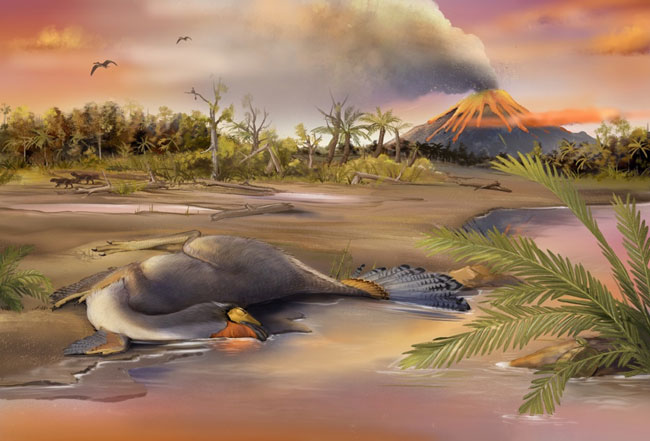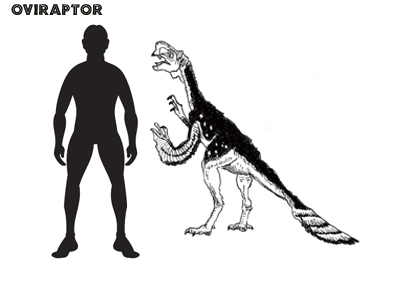Remarkable Dinosaur Fossils from the Yixian Formation Not Caused by Pompeii-like Catastrophes
Researchers have concluded that the remarkable fossils associated with the Yixian Formation of north-eastern China were not caused by Pompeii-like events. The prevailing view was that these amazing fossils, some of which are preserved in stunning detail, were formed due to violent volcanic eruptions, lahars or pyroclastic flows. However, a team of scientists writing in the journal the “Proceedings of the National Academy of Sciences”, have challenged this hypothesis. Instead, it is suggested that the deposition took place over a period of less than 100,000 years. Furthermore, more mundane factors were at work, such as high rainfall, causing the burrows of animals to collapse.

Study co-author Paul Olsen exploring the quarry where the first feathered non-avian dinosaur was found in 1996 (Sinosauropteryx). If these fossils had formed as a result of violent volcanic events, it would have been highly unlikely that delicate structures such as feathers would have been preserved. Picture credit: Paul Olsen/Lamont-Doherty Earth Observatory.
Picture credit: Paul Olsen/Lamont-Doherty Earth Observatory
Far from representing Pompeii-like catastrophes, the scientists conclude that the deposits provide a brief snapshot of normal life and death in an Early Cretaceous continental community.
The Incredible Fossils of the Yixian Formation
The Lower Cretaceous deposits of the Yixian Formation exposed in Liaoning Province (north-eastern China) were virtually unexplored until the 1980s. Villagers reported finding beautiful fossil specimens, representing all kinds of creatures that once lived in a forested environment that contained large lakes. The rocks are believed to be around 125 million years old (Barremian faunal stage). Fossils of dinosaurs, pterosaurs, birds, mammals, amphibians, reptiles, fish and insects have been found. Some of the most famous fossils ever found come from this part of China.
Since the first, remarkable discoveries there has been fossil gold rush with an extensive network of fossil dealers and retail outlets springing up. Both locals and scientific field teams have excavated the area so much, the dig sites can be seen from space. These are perhaps the most extensive palaeontological excavations on Earth.

The corpse of a feathered dinosaur lies on the lake shore whilst a pair of Psittacosaurus wander past and pterosaurs fly overhead. It had been thought that the beautiful fossils of the Yixian Formation were formed as a result of volcanic activity. Picture credit: Zheng Qiuyang.
Picture credit: Zheng Qiuyang
Flattened Fossils or Three-dimensional Fossils
The fossils occur as flattened with soft tissue preservation (including feathers and melanosomes) in laminated lacustrine strata (lake sediments) or as three-dimensional almost complete, articulated skeletons in more terrestrial orientated deposits. The discoveries include the first documented evidence of a mammal attacking a dinosaur.
To read more about this amazing fossil discovery: Repenomamus Attacks Psittacosaurus.
Co-author of the study, Paul Olsen a palaeontologist at the Columbia University’s Lamont-Doherty Earth Observatory, commented:
“These are probably the most important dinosaur discoveries of the last 120 years. But what was said about their method of preservation highlights an important human bias. That is, to ascribe extraordinary causes, i.e. miracles, to ordinary events when we don’t understand their origins. These [fossils] are just a snapshot of everyday deaths in normal conditions over a relatively brief time.”
Analysing Grains of Zircon
Lead author of the research, Scott MacLennan (University of Witwatersrand) analysed tiny grains of the mineral zircon taken from the fossil matrix and the actual fossils. With these samples, he measured the ratios of radioactive uranium as it decays into lead. This rate of radioactive decay is constant. As a result, he was able to date the material with a high degree of accuracy. These fossils were formed around 125.8 million years ago, centred around a period of less than 93,000 years.
Further calculations showed that this timeframe contained three periods controlled by variations in the Earth’s orbit when the weather was relatively wet. This caused sediments to build up in lakes and on land much more quickly than previously had been thought. Many already deceased animals were quickly buried, and oxygen that normally would fuel decomposition was sealed out. The sealing effect was fastest in lakes, resulting in the preservation of soft tissues.
This explains why two types of fossils occur.

A field team from the Nanjing Institute of Geology and Palaeontology exploring Yixian Formation exposures (Lujiatun Member). Many Psittacosaurus fossils have been found at this locality. On the right of the photograph is one of the quarries dug by local people in search of fossils to sell. Picture credit: Paul Olsen/Lamont-Doherty Earth Observatory.
Picture credit: Paul Olsen/Lamont-Doherty Earth Observatory
Fossil Preservation Not Connected to Volcanism
The scientists have discounted volcanism. Previous studies have suggested that some animals were entombed in lahars. These are fast-moving concrete-like slurries of mud that flow from volcanoes following eruptions. However, lahars are extremely violent, preserving animal skeletons intact, with soft tissues preserved would be most unlikely.
In addition, other researchers have suggested that the preservation occurred due to pyroclastic flows. Pyroclastic flows involve rapidly moving waves of hot ash and poisonous gases, the sort of event that led to the remarkable preservation found in Pompeii.
There are layers of volcanic ash and lava within the layers of rock that form the Yixian Formation. However, the fossil remains include delicate structures such as feathers and stomach contents, which could not have survived such traumatic incidents. The scientists conclude that the evidence indicates sudden burrow collapses. For example, the famous Repenomamus attacking the Psittacosaurus, a battle preserved in time, could have occurred when the mammal invaded the dinosaur’s burrow, and the burrow subsequently collapsed.
Rather than representing multiple, Pompeii-like terrible events, the Yixian Formation is instead a brief snapshot of normal life and death in an Early Cretaceous ecosystem.
An Economy Centred Around the Yixian Formation
Whatever, the reason for the fossil preservation, Liaoning Province is now one of the most famous parts of China. These remarkable fossils attract tourists, and an entire industry has sprung up with extensive trading in fossil souvenirs.

Potential buyers examine fossils at a shop in the city of Chaoyang (Liaoning Province), a centre of the Chinese fossil trade. Picture credit: Paul Olsen/Lamont-Doherty Earth Observatory.
Picture credit: Paul Olsen/Lamont-Doherty Earth Observatory
Everything Dinosaur acknowledges the assistance of a media release from The Earth Institute/Columbia Climate School (Columbia University) in the compilation of this article.
The scientific paper: “Extremely rapid, yet noncatastrophic, preservation of the flattened-feathered and 3D dinosaurs of the Early Cretaceous of China” by Scott A. MacLennan, Jingeng Sha, Paul E. Olsen, Sean T. Kinney, Clara Chang, Yanan Fang, Jun Liu, Bennett B. Slibeck, Elaine Chen and Blair Schoene published in the PNAS.
The award-winning Everything Dinosaur website: Dinosaur Toys and Models.



















